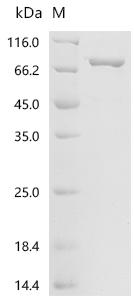Recombinant Escherichia coli Colicin-Ia (cia) is expressed in E.coli and contains the complete sequence spanning amino acids 1 to 626. The protein comes equipped with a C-terminal 6xHis tag, which makes purification and detection more straightforward. Based on SDS-PAGE analysis, the product appears to achieve high purity levels—over 90%—suggesting it's well-suited for different experimental research applications.
Colicin-Ia is a bacteriocin that E. coli naturally produces, and it seems to play a key role in bacterial warfare. The protein works by targeting and eliminating vulnerable bacterial strains, which likely helps the producer bacteria gain an edge in competitive situations. This makes Colicin-Ia a valuable research tool for examining how microbes interact with each other. It may also shed light on bacterial defense strategies, contributing to our understanding of bacterial ecology and host-pathogen dynamics.
Potential Applications
Note: The applications listed below are based on what we know about this protein's biological functions, published research, and experience from experts in the field. However, we haven't fully tested all of these applications ourselves yet. We'd recommend running some preliminary tests first to make sure they work for your specific research goals.
Based on the provided information, the recombinant E. coli Colicin-Ia is expressed in its native E. coli system, which significantly increases the probability of proper folding and functionality. As a bacterial toxin naturally produced by E. coli, the cellular environment contains the necessary chaperones and folding machinery for correct structure formation. The protein is full-length (1-626aa) with a C-terminal 6xHis tag and high purity (>90%). The C-terminal tag placement is advantageous as it minimizes interference with the N-terminal functional domains critical for receptor binding and pore formation. However, since activity is unverified and colicins require precise folding for their complex mechanism (receptor binding, translocation, and pore formation), the protein cannot be assumed to be fully functional without experimental validation of its bactericidal activity.
1. Protein-Protein Interaction Studies Using His-Tag Affinity Purification
The C-terminal 6xHis tag enables technical feasibility for pull-down assays. However, if Colicin-Ia is misfolded or inactive, identified interactions may not reflect physiological binding partners (e.g., BtuB receptor, Tol proteins). This application should include proper controls and validation with known interactors. The high purity reduces background but doesn't guarantee functional folding.
2. Antibody Development and Immunoassay Applications
The recombinant Colicin-Ia can serve as an effective immunogen for generating antibodies against linear epitopes. The full-length sequence ensures comprehensive epitope coverage. Validation against native colicin from producing strains is recommended to confirm antibody specificity.
3. Biochemical Characterization and Stability Studies
This application is well-suited for assessing the recombinant E. coli Colicin-Ia. Techniques like circular dichroism spectroscopy, analytical ultracentrifugation, and thermal shift assays can evaluate folding state and stability. These studies are valuable for quality control even if the protein's biological activity is unconfirmed.
4. Comparative Structural Analysis by Electron Microscopy
This application requires caution. While the high purity supports structural studies, negative stain EM may reveal artifactual oligomerization if the protein is misfolded. The His-tag may facilitate grid binding but could induce non-physiological aggregation. This should be pursued only after confirming proper folding and monodispersity.
Final Recommendation & Action Plan
Given the homologous expression system, this recombinant Colicin-Ia has high potential for proper folding. Recommended first steps: 1) Validate bactericidal activity against sensitive E. coli strains; 2) Perform biophysical characterization (size-exclusion chromatography, circular dichroism) to confirm proper folding and oligomeric state; 3) For interaction studies, include known receptor proteins as positive controls. Antibody development and biochemical characterization can proceed immediately. Structural studies should await confirmation of proper folding and monodispersity. Always include appropriate controls such as active colicin standards, and validate findings with native protein when possible.






